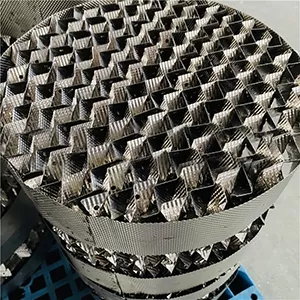Is Structured Corrugated Plate Packing Resistant to High Temperatures?
The high-temperature resistance of structured corrugated plate packing depends primarily on the material from which it is manufactured. Different materials exhibit varying levels of tolerance to elevated temperatures, making this a critical factor in selecting the right packing for high-temperature industrial processes.

Metal-based structured corrugated plate packing, such as those made from stainless steel, carbon steel, or nickel alloys, is generally highly resistant to high temperatures. Stainless steel packing, for example, can typically withstand temperatures ranging from 300°C to 600°C, depending on the specific grade; high-grade alloys like Inconel may tolerate even higher temperatures, exceeding 800°C in some cases. This makes metal corrugated plate packing suitable for high-temperature applications such as distillation in petrochemical plants, where process temperatures often reach several hundred degrees Celsius.
Ceramic structured corrugated plate packing is another excellent choice for high-temperature environments. Ceramic materials are inherently heat-resistant and can endure temperatures well above 1000°C, making them ideal for extreme conditions such as those encountered in industrial furnaces or high-temperature gas absorption processes. Their resistance to thermal shock and chemical corrosion further enhances their suitability for harsh, high-heat operations.
In contrast, plastic-based structured corrugated plate packing (e.g., made from polypropylene or PVC) has limited high-temperature resistance. Most plastics begin to soften or degrade at temperatures above 100–150°C, depending on the type. Polypropylene, for instance, typically loses its structural integrity at temperatures exceeding 120–150°C, making plastic corrugated plate packing unsuitable for high-temperature processes. They are more commonly used in low to moderate temperature applications such as water treatment or ambient-temperature chemical separation.
It is important to note that even within metal or ceramic categories, the specific material grade and manufacturing quality influence high-temperature performance. For example, carbon steel may oxidize at high temperatures over time, while stainless steel with higher chromium content offers better oxidation resistance. Similarly, ceramic packing with high alumina content tends to have superior thermal stability compared to lower-grade ceramics.
In summary, structured corrugated plate packing can be resistant to high temperatures, but this depends entirely on the material. Metal and ceramic varieties are well-suited for high-temperature processes, withstanding hundreds to over a thousand degrees Celsius, while plastic-based options are limited to low to moderate temperatures. Material selection should align with the specific temperature requirements of the application to ensure long-term performance and safety.

